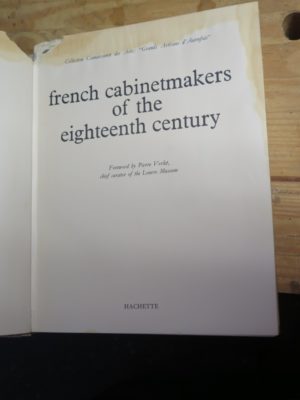
A while ago in my quest to gather pertinent books regarding the artistry of the World of Roubo, and in fact the larger portrait of the culture surrounding him (in part due to my desire to replicate the work, in part due to my ongoing efforts to write a novel for which one thread involves Parisian cabinetmaking c.1770), I went on a sustained book-buying spree. For the most part that spree has ended with only one or two exceptions, and my absence from abebooks.com has led them to send me a “Get Well Soon” card. Just kidding about that, but it had been a very long while before a recent purchase or two.
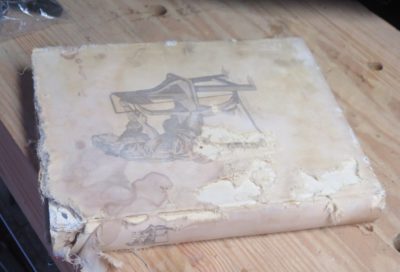
One of my last purchases perhaps three or four years ago was, at that time, a somewhat hard-to-find book that was equally hard-to-afford. While browsing my barn library a couple weeks ago a faint familiar stench prompted the memory of this book. When it first arrived and I opened the package I knew immediately why I could afford it. Yes, it was in poor physical condition, but I knew that already. What I did not know at the time was the someone had doused the volume with perfume, and I mean doused. It was probably to disguise up the odor of mildew or rodent urine/feces or who knows what. When I first opened it the perfume actually burned my eyes it was so strong.
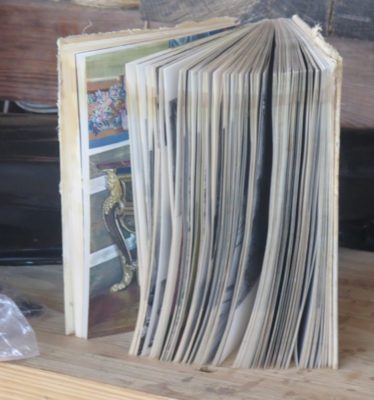
I bagged it back up and set it aside to deal with it “another day.” Since coming across it again, and desiring to actually read it without wearing a gas mask, I splayed it out on a bench way away from my work space. I checked it gain and it is still odoriferous. I think I will have to put it inside a sealed rubber tub with a lot of activated charcoal and probably swap out the charcoal a time or four to extract the stench enough for me to hold it at reading distance.
Peeeyuwww!
I’ll let you know how that goes.
I think I am more or less back on track, compewder-wise. I took some advice from RalphB and placed a sledge hammer next to the keyboard and spoke to the compewder in calm but undeniably threatening terms. It has been behaving better ever since. Actually, compewder guru Tim had a session with it. — DCW
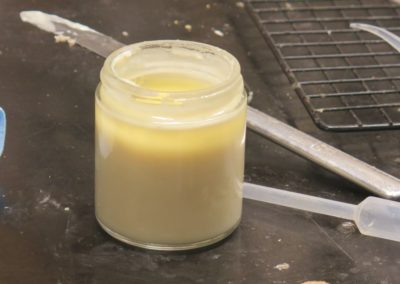
As we left the (mis)-adventure with the batch of Mel’s Wax having identified and solved the problem, I was left with a large batch of the misbehaving product to deal with. Of course my question was, “Can I recover this and make it useful?”
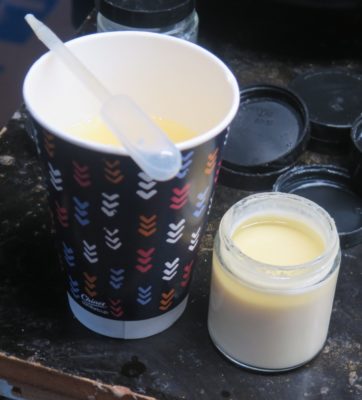
I first let the emulsions sit for a week or so then decanted off the excess solvent from the top of the jars with a pipette. The result was a couple of paper cups filled with nearly pure solvent which I merely disposed of as it was of no use to me. I was careful to not dip the pipette too far down into the liquid so as to leave the emulsion itself untouched. This cautious approach left a small amount of excess solvent fraction stratum on top of the liquid.
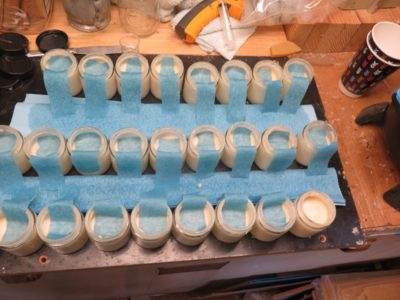
I decided to remove this excess fraction using techniques familiar with anyone who has ever undertaken some liquid chromatography, I simply wicked off the surface excess by draping in a strip of paper towel on top.
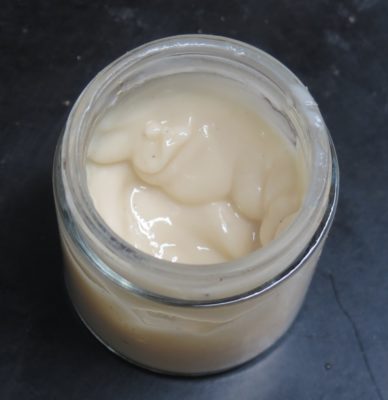

The ultimate result of this approach was to arrive at the balanced formulation with the emulsion performing and behaving exactly a it as supposed to behave and perform. Nevertheless this was not product I was going to sell given the log and winding road, so I now have couple dozen jars I will give away to friends and barn visitors.

Thanks to a recommendation from my friend Steve Voigt I will be trying a new source for the solvent and will re-calibrate the formulation for future batches.
NB – This is not only my 1,500th(!) blog post over the past 8+ years, it is the longest one I’ve ever written. By far. Normally a post takes me from 30-90 minutes to create, occasionally longer or shorter. For this one, depending on your timekeeping system it took me a) four weeks, b) four months, c) four years, or d) four decades. So which one was it?
The correct answer is, “Yes.”

In order to tell this tale with some completeness I need to give you a tiny bit of background context. (In truth it turned out to be something more than a “tiny bit” but it is far less than a proper detailed exposition. I think that would be too much for 99.8% of you, and since I have about 300 readers that pretty much eliminates everybody — DCW)
To determine the cause of the soup-iness of the batch of Mel’s Wax, it should be the viscosity of a lotion and was instead the viscosity of heavy cream, I needed to go back to the beginning to reflect on the original concept for the formulation. This will be long and winding tale but provides the fullest possible explanation I am able to share about the reason for the batch “failure” (as I said earlier it was not really a failure, it was just not the precise outcome I had expected. In the end it turned out just fine.) I should probably break it up into three or four posts, but I decided to just put in one big steak rather than several smaller burgers. So, settle in with a snack and your preferred beverage for this ride. I don’t think you necessarily need to buckle up, but if a discussion of solvent thermodynamics gets you all worked up into a rave perhaps you need to restrain yourself as well.
BTW This post borrows heavily from the section that has been the bane for the past year of writing A Period Finisher’s Manual. And yes I have finally solved that particular puzzle and am back at work on APFM almost daily. Yup, it has taken me over a year to get a handle on one part of one chapter. Were it not so important to the craft of wood finishing I would not have bothered, but it is and I did.
From the beginning of our careers, even before we met and worked together, Mel and I formulated and mixed our own furniture maintenance polishes because we were not content with the products in the market. The commercially available products often used ingredients we knew a priori to be potentially deleterious to historic finishes, or used ingredients in proportions we thought were not optimal (for the furniture), or were simply too difficult to use.
So, the product Mel finally derived (I withdrew from direct participation fairly early for logistical reasons once we knew the development was on the right track; the easiest way for the project to move forward was for me as Mel’s Supervisor to assign him the task of taking it to fruition with me providing oversight and the occasional observation, review, or suggestion. Participating directly, as a Supervisor and programmatic manager [read: fiduciary] would have been an administrative nightmare) fulfilled splendidly our goals for “the ultimate furniture polish.” I do not believe it to overstate the case when I note that from a formulary’s perspective, it was balancing along a knife’s edge. That balance was lost minutely in mixing this batch of the polish, but that is all it took.
Here were the original goals, which Mel fulfilled brilliantly and deserves all of the credit and the Patents* that were issued.
- The end product was archivally stable.
- The product was chemically benign regarding historic finishes.
- The product was physically benign regarding historic finishes; the product was easy to apply and bring to a high sheen.
- The product was very high performance for both the presentation of the object and its ongoing maintenance.
- The product was easily removed with no damage to the surface from the removal process.
- The production of the polish did not require exotic technology
- The product was safe for the user.
These features are not independent variables per se, no component of any formulation or application is separated from the others, but they are different conceptually and thus I will provide exposition on each one.
Archivally Stable
“Archival” is at best a vague word without objective quantifiable meaning, but for the sake of this discussion simply use it to mean that some material or composition of materials does not degrade unacceptably fast and that any degradation by-products do not become manifest as pernicious actors in the realm of deterioration. That does not mean the word/concept has no utility when formulating a composition or even a practice. For Mel’s Wax the ingredients and their proportions/mixing were chosen with great care, and selected for long-term stability. This has pretty profound influence on the making and shelf-life of the product. Though the primary ingredients of Mel’s Wax (the waxes themselves) have a half-life that is near-infinite within the context of recorded human history, others were selected for the longest possible half-life, such as the exotic emulsifiers. And, the ingredients were selected with essentially zero cost consideration. Think about an old favorite like Murphy’s Oil Soap, which retails for a few dollars a quart. The emulsifiers used in Mel’s Wax, again, selected because of their stability vis-a-vie their degradation curve and chemical neutrality (see below) wholesales for *hundreds of dollars a liter.*
Chemically Benign to Historic Finishes
One of the truths of this particular cosmos is that the Law of Entropy cannot be repealed by even the most highly self-esteemed persons. “Ashes to ashes dust to dust” is not merely funereal homily, it is an inexorable reality in a cosmos governed by the laws of thermodynamics. So, as furniture finishes age they become closer to the “dirt” aspect of the verbiage just cited. As a practical matter this means that historic surfaces and finishes become more chemically imbalanced over time (usually due to UV damage or the imbibing of oxygen) and thus more susceptible to chemicals that impart damage because the chemicals deposited on the surfaces are thermodynamically similar to the surface and will thus impart undue harm to the said surface. This means that we have to maintain as close to a neutral balance or “polarity” for the chemical concoction being deposited on that surface. This, in turn, affects the choice of ingredients to be the most benign possible, which in turn influences the procedures for making Mel’s Wax. Those crazy expensive emulsifiers I mentioned earlier were selected specifically because they are less aggressive in creating the lotion-like polish, and thus less likely to inflict harm on chemically fragile surface. Further, the proportion of the emulsifiers in precisely calculated since excess emulsifier is a vector for accelerated chemical reactions, a/k/a “deterioration.” Also, the selection of the organic solvents used in creating the oil-and-water emulsion were selected for the maximum benign characteristics for aged surfaces.
Physically Benign to Historic Surfaces
There are some fine archival and chemically neutral furniture care polishes on the market in the form of paste waxes. Unfortunately many of these products require sometimes aggressive rubbing of the surface to bring their applications to a conclusion. Whenever you are faced with a physically delicate surface the last thing in the world you want to do is rub it hard to burnish the maintenance coating (paste wax). Given that reality based on what we knew it was pretty apparent that Mel’s Wax would need to be a creamy emulsion requiring very little physical impact on the surface for either application or completion.
High Performance
“High performance” is just another way of saying “It is physically robust and looks good.” It is and it does.
Easily Removable
For long term preservation and care considerations any museum artifact maintenance product must be removable with the minimal physical or chemical impact on the sometimes fragile underlying surface. Mel’s Wax was designed precisely to be removable with non-polar solvents and soft wipes like cotton swabs or lint-free felt.
Easily Produced
This was the point that precluded commercial-scale productions. It is very fussy to make, in fact my experience is that it would be difficult to make in anything larger than a five-gallon batch; I normally make Mel’s Wax just over a gallon at a time. The ingredients must be mixed precisely and with a fairly strict time frame. Further, the thermal ramping (the rate of heating up and cooling down) is a real stinker. Commercial enterprises, used to making home-care products in vats of several hundred gallons at a time, could simply not get it right. Many companies tried, including some you might recognize; they all failed. Instead the protocol Mel derived was a fussy micro-batch process that can go south with just a fraction of a percent of deviation. In that regard it failed the “easy to produce” goal.
Safe to Use
Not incidental to the formulation design is that the end product would not only be benign for the artifact, it would be (comparatively) benign for the user. Yes Mel’s Wax does contain organic solvents that are by definition deleterious to human consumption, but they are not acutely toxic compared to the overall landscape of industrial chemical engineering and formulation. Eating or drinking it would end you up in the emergency room rather than the morgue. As Dixie Lee Ray articulated in the Foreword to her brilliant book Trashing The Planet, under many situations di-hydrogen monoxide (water) is a lethal chemical. Like, for example, if you were to experience extended, intimate and excusive exposure for more than a couple minutes, e.g. unmitigated complete submersion. That would be a fatal incident.
Back to “The Cause”
This, my friends, is here the adventurous rabbit trail of solvent thermodynamics comes into play. As I mentioned earlier the formulation for Mels Wax was a razor’s-edge situation; if any component of the manufacturing was off by just a smidge, whether ingredient, proportion or process, the delicate balance of the formulation would be undone, or at least modified from where it was supposed to end up.
And that is what happened, but not in the way I was expecting. Solving the problem was an energizing exercise in synthetic thinking, combining the phenomenon (that which can be observed) with the noumenon (that which can be imagined).

When I was making this batch I was relying on my old faithful solvent, odorless mineral spirits, from the hardware store. There is nothing wrong with generic or even common ingredients like this provided they are the same thing from the manufacturer every time. I’d had great success with this particular solvent over the years. However, this time when I opened the container and decanted the necessary amount of the solvent into the weighing vessel (the formula is designed to assemble the ingredients by weight, not volume) the solvent coming out of the container was the consistency of chunky sour milk (fortunately it was odorless). Clearly some “shelf life” issue of the solvent and its plastic container was at work here. I tossed all of that and cleaned up to move on to the next gallon jug. Same thing. Repeat and rinse. Same thing. And with that I was out of my trusty tried and true odorless mineral spirits.
No big deal, I just picked up some new solvent, from the same company to (supposedly) the same manufacturing specs, and proceeded as normal. The solvent looked fine, the procedure went smoothly and I set about with other tasks until the polish gelled to the expected creamy lotion viscosity.
I came back in an hour and the polish had not gelled. No reason for hysteria, it as a very warm day and the thermal ramping was just being petulant. I came back in the morning and the gelling was still not to my satisfaction. Hmm, what was going on here? I even refrigerated one jar and it did not thicken to the desired viscosity.

At this point I stepped back from the entire episode for two weeks, just letting the stuff sit on the benchtop of the Waxerie while I cogitated. After those fourteen days I revisited the batch of the polish and noticed something peculiar — there was a stratum of pure solvent at the top of every jar. In a moment I knew what had happened.
The Crystal Set/Key-and-Lock Analogies – The Solubility Parameter
Have you ever wondered why substance A will dissolve in solvent X but not solvent Z? That question is perhaps one of the very most important questions in coatings technology and you would be wise to contemplate it. There is a real answer and I am going to tell it to you in a roundabout fashion. Hey, it’s my blog and I can tell the story any way I want. Hint -it all has to do with interatomic/intermolecular energy matching.
Stick with me now.
When I was a kid I got a crystal set radio, an earth-powered (actually it was the charge from the earth through the grounded radio chassis that made it work) primitive AM radio that allowed me to get the closest radio station to the house. I would spend many evenings listening to that local radio station, and after dark when the locals went off the air I could tune in the station from the next town over. Even though the crystal set had no power source I could listen to broadcast radio. Why? because the crystal of the crystal set allowed the unit to align, or match (receive), the frequency of the signal being broadcast with power being derived from the ground (I am not a radio engineer and did not stay in a Holiday Inn, so cut me some slack. I’m trying to explain a concept, not enter the debate about Marconi vs Tesla vs. Edison). Even with only the nearly unmeasurable electrons flowing through the crystal set it could “dissolve” the radio signals being broadcast because they were matched to each other.
Let me try another analogy.
Assume you come to visit me and my barn is locked (the punch line of my all time favorite joke is, “Assume a can opener.”). Not to worry, you’ve got the biggest honkin’ key known to man in your pocket and you go after the lock on my door. (I am assuming this action is done with my permission or you would have likely suffered a less beneficial outcome). Is this going to work, are you going to get in? Probably not. Why? Because the configuration (the energy) of the key does not match the configuration (the energy) of the tumblers in the lock.
And that my friends is why the polish was soupy. Let me explain.

The “solubility parameter” is the aggregate of (at least) three fractional components, which are in turn very specific intermolecular energy values. We use a graphical tool called the Teas Diagram to visually plot out the dissolving characteristics of both solvents and solutes, although this is an incomplete tool for selecting ingredients in a finish formulation. I discuss this at some length in A Period Finisher’s Manual.
The formula for Mel’s Wax depends on an organic solvent blend of a particular energy balance or “polarity” in order to walk the razor’s edge and fulfill all the preferences described above. To work perfectly the energy holding the solvent blend together (the key) had to match the energy holding the ingredients together (the lock) precisely — not perfectly — in order to accomplish the end point we wanted. My old dominant solvent had the exact correct energies to match the ingredients were were putting into solution in this particular operation. This phenomenon is called the “solubility parameter” as it is literally the aggregation of the interatomic and intermolecular electrical forces holding everything together, at least in the universe of solutes and solvents. Often it is reduce to the verbal shorthand of “like dissolves like.”
Yes, there are solvents for Mel’s Wax that could do the dissolving more efficiently than others. Solvent/solute compatibility is a range not a fixed point since no solute or solvent is 100% a pure single molecular content, and within one particular range we got the desired outcome. Was this solvent blend the “perfect” one to create the solution? No, because perfect solvation was not the preferred outcome since that “perfect” solvent blend would not fulfill the previously stated goals. For that we needed a milder (less polar) solvent blend. As I said the solubility parameter allows for a range of options to accomplish similar goals and characteristics.
Getting back to the original issue, why was this batch of polish soupy? Because even though the new solvent as ostensibly identical or similar to the previous solvent (it was similar but not identical) and still well within the “safe” range or creating our archival polish, it was just enough different as to perform more efficiently as a solvent. In short, each unit of solvent dissolved more of the polish ingredients than the previous solvent, so less of the new solvent was needed to accomplish the task of doing the dissolving. In a normal solvent/solute solution this is usually no big deal, the solution is just a tiny bit more diluted than would otherwise be expected. But, in a two phase system like an emulsion combining an oily fraction with a watery fraction even minute deviations can impart huge differences.
In the end, the polish was soupy because there was excess solvent that had nothing to do but sit around and be liquid adjacent to the two phase emulsion. Yes I could force it to go into the emulsion but it would not stay there. As I showed last time the performance of the polish was unaffected. It was just soupy, that’s all.
But I didn’t want soupy so stay tuned for the next episode of As The Polish Turns to see how I responded to the problem.
Once apon a time I thought making and selling Mel’s Wax would be a foundational activity for me in “retirement.” I believed the product invented for the archival care of furniture and wooden artifacts while we were together at the Smithsonian would grow into a prominent role at The Barn (half of any proceeds go to Mel’s widow.) The custom-designed performance and formulation was unlike anything else available to furniture caretakers, and one major player in the home care products market whom we approached to manufacture it declared it to be (when cutting through the corporate-ese) “…the best product of its kind we have ever seen, but we have too much invested in our own brand to pursue it.”
Instead it has become a minor amusement for me as there seems to be little interest in the product. Admittedly this might be because I will not turn it over to some third party for production and marketing. It is a fussy product to make, and its applications may be too niche. We found that every potential producer who tried to make it cut corners and substituted more “convenient” ingredients (read: cheaper) or made other modifications to the formula and process to the disadvantage of the product concept and performance.
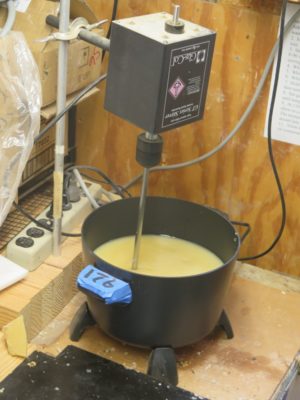
So, instead of working at anything near my capacity of a one-man shop, even if expanding that to a one-man-and-his-really-smart-wife, I find myself making batch (28 units) every so often. Last year while mail-order businesses boomed in general, I sold exactly 17 units. This year is better, having outsold 2020 by a factor of three already, so I was needing to make another batch last week, the third one this year! Normally I make it during the winter when things are cool in the shop (I keep it around 60) but we are now in the throes of a heat wave (low 80s).
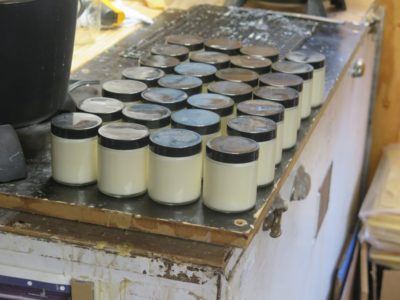
While making the batch it seemed “off” and I set it aside for several days to settle down (sometimes it takes a while for the emulsion to fully set). When I checked back a week later it was still “off” (had not settled into the “lotion” viscosity) and I wondered if ambient heat was the issue. I’ve placed it in the basement of the barn (60 degrees) to set for a day or two and I will check it again. If I still do not like it I will make a whole new batch.

Aside from the digital analytical scales I use to get the ingredient proportions correct, the most important tool in the process is a laser thermometer. Ramping up the temperature and (as important, if not more so) ramping the temperature down is vital to making Mel’s Wax.
This episode not only made me go, “Hmmm,” but reminded me how finicky it is to make.
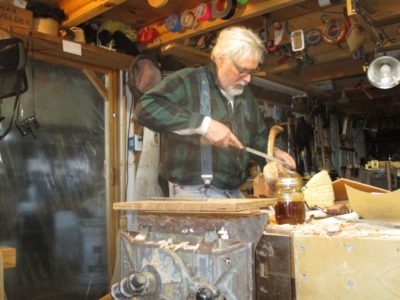
My original strategy for sculpting a lovely kitchen accessory for Mrs. Barn’s Christmas was to gently work both the inside and outside of the workpiece until something beautiful and functional could be obtained.


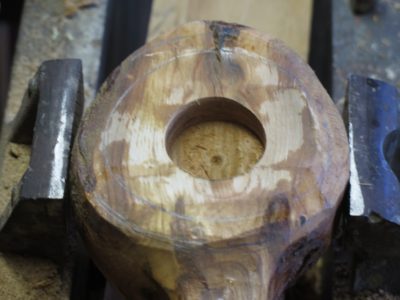
As I mentioned earlier I knew right away that cheating via drilled excavation was the way to proceed with the inside of the bowl. The nature of the piece’s morphology would constrain me to slow and gentle work, no wailing away on this one. Still my plan was to carve and excavate, drill a little, then carve and excavate some more until it was finished. 3-4 mornings max, no problem.
Sure.
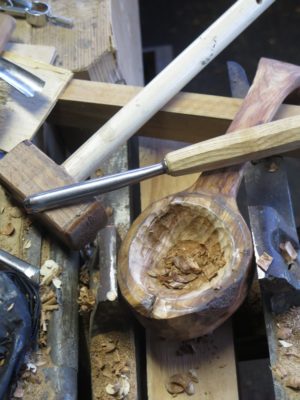

As I got deeper into the bowl of the spoon/ladle I encountered my worst “working burl” nightmare. The cherry burl was crumbly, as burls sometimes are, and caution and a turtle-like pace was called for. But even caution and a slow pace was not adequate for this piece of wood. It needed enhancement.
So, my routine for the next several dozen hours of working on the carving, spread over a dozen weeks, was to soak the entire bowl end of the workpiece with epoxy, allowing it three days to set fully, then carving until I hit crumbles again.
I did not use straight, full strength epoxy — that would have been a catastrophic failure on so many fronts — but rather my old faithful West System, diluted roughly by 1/3 with acetone to allow for greatest penetration when I slathered it on until the surface was fully wet. Even so the effective saturation was only so deep.
With this protocol, slowly but surely the piece began to take shape. My dream of getting this done by Halloween and moving on to other things was not dead but it did require some creative scheduling. I did this for little time, then I did that, then the other thing. Actually if fit rather nicely into my ADHD.

I suppose it is a sign of the current state of affairs that I spent a little time yesterday gathering the supplies necessary and then making several bottles of hand sterilizer.
I mixed equal amounts of Everclear 151 proof grain alcohol with 70% rubbing alcohol, then added Carbopol 941 polyacrylic acid as the gelling agent, about two spoonsful per pint. My Carbopol had hardened into a block so I needed to toss a nugget into a mortar bowl and pulverize into a powder with the pestle.
I added the Carbopol powder slowly through a strainer for better dispersion into the mixing bowl with the stirrer going just enough to move the materials (alky, the distilled water portion, and the powdered gelling agent) around for about ten minutes to fully hydrate the powder, then let it sit. Since it acts by gelling only the water the gelation was quite slow, several hours, since the water portion of the solution was only around 1/4. This was actually very helpful as I could then decant the slightly-thickened-but-still-gelling liquid into the dispensers.
This morning I have three dispensers sitting on the dining table with the contents looking perfect, two 4 oz. bottles to carry in our pockets and one 8 oz. jar for use wherever. I also refilled my spout top dispenser in the barn, which I will not use much now that the water is turned back on and I can wash my hands with soap and water.
Stay isolated and safe in this time of martial law, er, mandatory house arrest, er, whatever, folks. (“A rose by any other name…”)

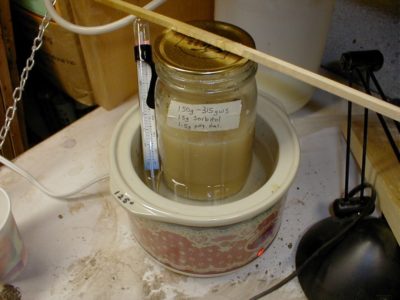
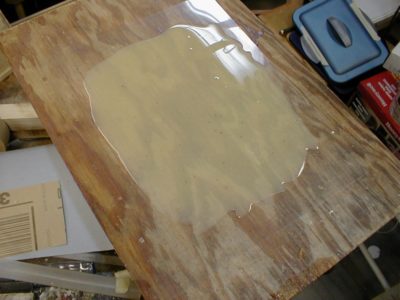
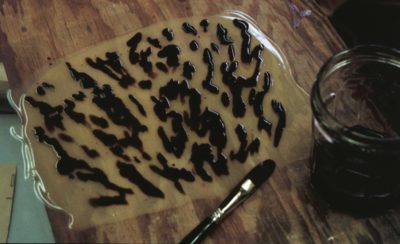

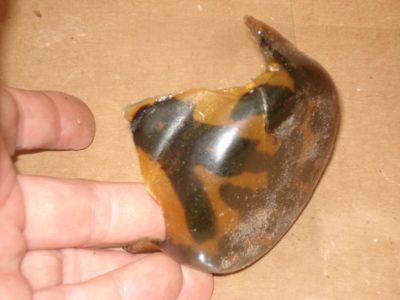
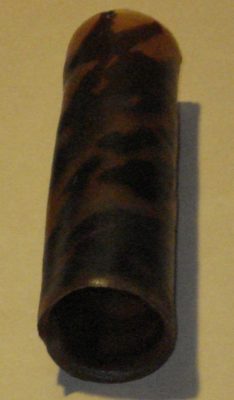
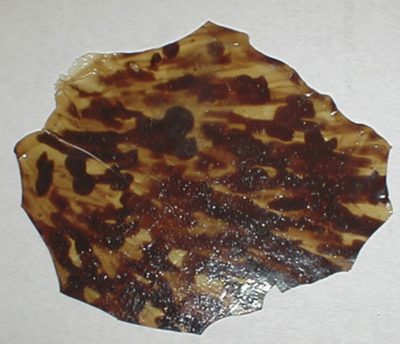
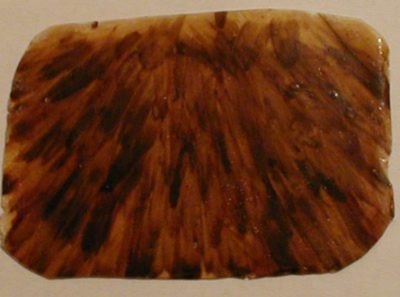
























Recent Comments